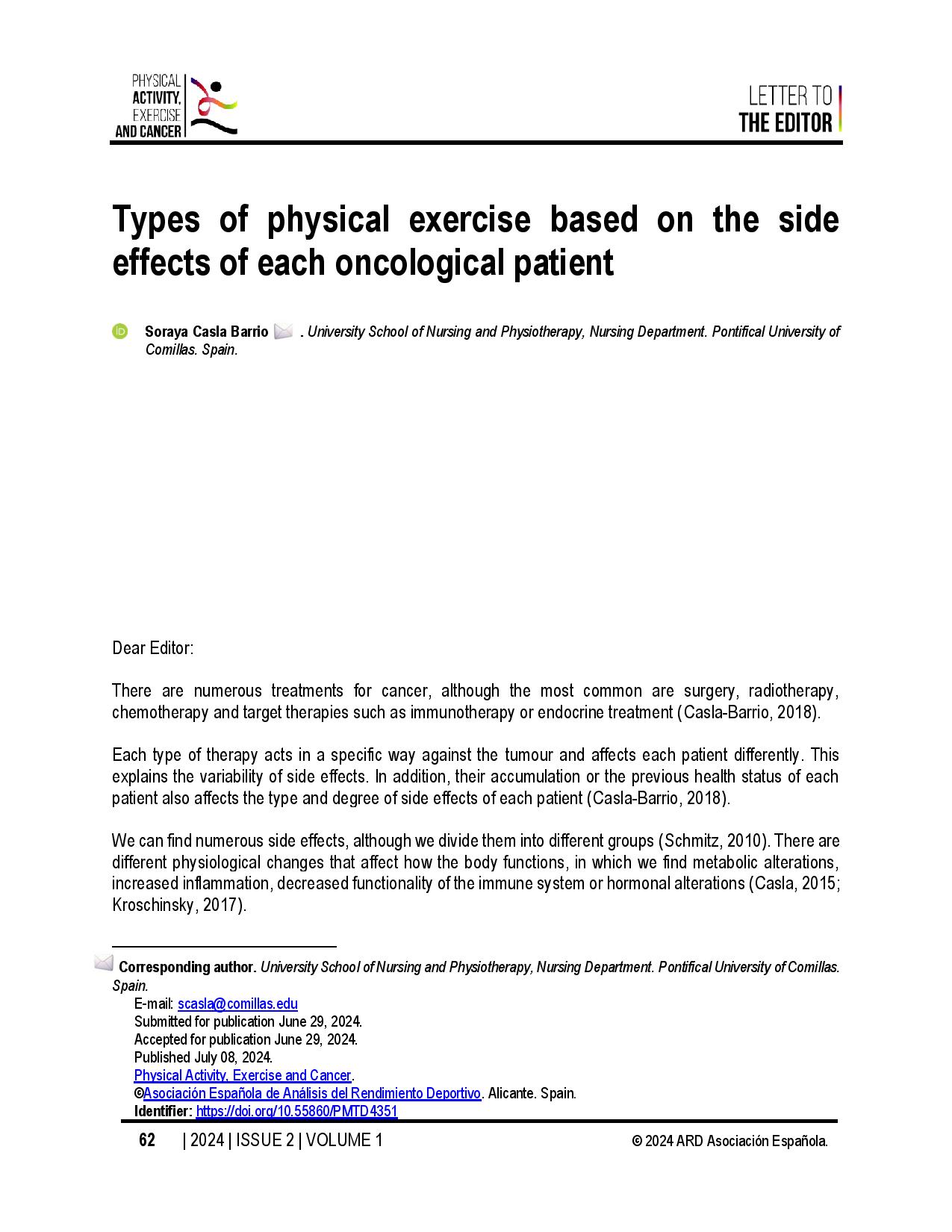Types of physical exercise based on the side effects of each oncological patient
Main Article Content
Abstract
Cancer treatments like surgery, radiotherapy, chemotherapy, and target therapies can have various side effects on patients, affecting their health and quality of life. Exercise has been shown to be effective in reducing these side effects by regulating hormone levels, improving immune function, and reducing inflammation. The American College of Sports Medicine recommends a specific exercise regimen for cancer patients, including cardiovascular exercise and strength training. It is important to tailor exercise programs to each patient's needs and adapt the intensity based on their condition and disease stage. Understanding the physiological effects of cancer treatments is crucial for developing effective exercise programs that benefit patients. Motivating patients to stay active and adhere to exercise routines long term is also essential for their overall well-being.
Article Details

This work is licensed under a Creative Commons Attribution-NonCommercial-ShareAlike 4.0 International License.
References
Campbell KL, Makar KW, Kratz M, Foster-Schubert KE, McTiernan A, Ulrich CM. (2009). A pilot study of sampling subcutaneous adipose tissue to examine biomarkers of cancer risk. Cancer Prev Res (Phila). 2(1):37-42. https://doi.org/10.1158/1940-6207.CAPR-08-0073
Campbell KL, Winters-Stone KM, Wiskemann J, May AM, Schwartz AL, Courneya KS, et al. (2019). Exercise Guidelines for Cancer Survivors: Consensus Statement from International Multidisciplinary Roundtable. Med Sci Sports Exerc. 51(11):2375-90. https://doi.org/10.1249/MSS.0000000000002116
Casla S, Hojman P, Márquez-Rodas I, López-Tarruella S, Jerez Y, Barakat R, et al. (2015). Running away from side effects: physical exercise as a complementary intervention for breast cancer patients. Clinical and Translational Oncology. 17(3). https://doi.org/10.1007/s12094-014-1184-8
Casla-Barrio S, Alfaro-Gamero J, Casla Barrio S, Alfaro Gamero J, Casla-Barrio S, Alfaro-Gamero J. (2018). Exercise oncology. From theory to the practice. European Journal of Human Movement [Internet]. (41):24-48.
Daou HN. Exercise as an anti-inflammatory therapy for cancer cachexia: a focus on interleukin-6 regulation. (2020). Am J Physiol Regul Integr Comp Physiol. 318(2) : R296-310. https://doi.org/10.1152/ajpregu.00147.2019
Doyle TM, Salvemini D. (2021). Mini-Review: Mitochondrial dysfunction and chemotherapy-induced neuropathic pain. Neurosci Lett. 24;760:136087. https://doi.org/10.1016/j.neulet.2021.136087
Friedenreich CM, Neilson HK, Woolcott CG, Wang Q, Stanczyk FZ, McTiernan A, et al. (2012). Inflammatory marker changes in a yearlong randomized exercise intervention trial among postmenopausal women. Cancer Prev Res (Phila). 5(1):98-108. https://doi.org/10.1158/1940-6207.CAPR-11-0369
Kroschinsky F, Stölzel F, von Bonin S, Beutel G, Kochanek M, Kiehl M, et al. (2017). New drugs, new toxicities: severe side effects of modern targeted and immunotherapy of cancer and their management. Crit Care. 21(1):89. https://doi.org/10.1186/s13054-017-1678-1
McTiernan A, Friedenreich CM, Katzmarzyk PT, Powell KE, Macko R, Buchner D, et al. (2019). Physical Activity in Cancer Prevention and Survival: A Systematic Review. Med Sci Sports Exerc. 51(6):1252-61. https://doi.org/10.1249/MSS.0000000000001937
Pollán M, Casla-Barrio S, Alfaro J, Esteban C, Segui-Palmer MA, Lucia A, et al. (2020). Exercise and cancer: a position statement from the Spanish Society of Medical Oncology. Clin Transl Oncol. 22(10):1710-29. https://doi.org/10.1007/s12094-020-02312-y
Saberi S, Wheeler M, Bragg-Gresham J, Hornsby W, Agarwal PP, Attili A, et al. (2017). Effect of Moderate-Intensity Exercise Training on Peak Oxygen Consumption in Patients With Hypertrophic Cardiomyopathy: A Randomized Clinical Trial. JAMA. 317(13):1349-57. https://doi.org/10.1001/jama.2017.2503
Schmitz KH, Campbell AM, Stuiver MM, Pinto BM, Schwartz AL, Morris GS, et al. (2019). Exercise is medicine in oncology: Engaging clinicians to help patients move through cancer. CA Cancer J Clin. 69(6):468-84. https://doi.org/10.3322/caac.21579
Schmitz KH, Courneya KS, Matthews C, Demark-Wahnefried W, Galvão DA, Pinto BM, et al. (2010). American College of Sports Medicine roundtable on exercise guidelines for cancer survivors. Med Sci Sports Exerc. 42(7):1409-26. https://doi.org/10.1249/MSS.0b013e3181e0c112




